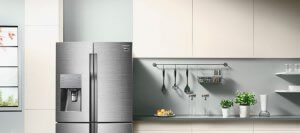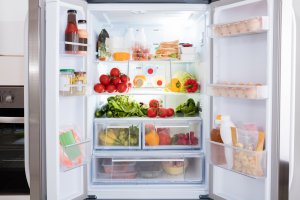Organize your Fridge With Our Top Tips

In recent years, the world has become obsessed with all things neat and tidy. But is it really so important to organize your fridge? The answer is simple – yes. Not only will having a tidy fridge save you time, but it will also help reduce stress, and make things much more efficient. So, are you ready to get your fridge in order?
When it comes to organization, the kitchen is one of the most important rooms in the house, especially when it comes to the refrigerator. Fridges work non-stop, day and night, helping to keep food fresher for longer.
Having a well-organized fridge not only helps keep food in optimal condition, but also helps prevent things from getting lost at the back, and allows you to better organize your weekly food plan.
How to organize your fridge
- Avoid letting your food touch the walls of the fridge, and be sure to leave space between each item to allow the cold air to circulate evenly.
- Use sealable containers to store your food. Otherwise, you risk cross-contamination.
- The temperature should be kept between 37 and 41°F.
- Get into the habit of storing newer items at the back of the fridge, and bringing older items to the front to ensure you use them before they spoil.
- Did you know that bacteria starts to multiply at temperatures as low as 46.4°F?

Foods you should never keep in the fridge
- Honey: cold affects the texture, flavor, and composition of honey. It should always be kept in a sealed jar at room temperature.
- Potatoes: potatoes contain starch, which the cold converts into sugars. This can actually make your potatoes taste sweeter than usual, and gives them a grainy texture.
- Onions: a cool, dry environment is the best place to keep onions. And keep them away from potatoes – together, they produce a gas which causes them to ripen more quickly.
- Tropical fruits, such as pineapple, bananas, and avocados are better off out of the fridge.
- Chocolate: it’s pretty normal to put chocolate in the fridge in summer right? But do you see that white stuff? That means the taste and texture have changed.
- Summer fruits such as melon, peaches, tomatoes, and zucchinis should always be kept at temperatures over 50°F.
- Here you’ll find a list of all the foods you should never store in the freezer.
How to organize your fridge: put everything in its place
If you really want to get your fridge organized, you need to understand that every shelf has been designed for a different purpose. Every food has its place. So, let’s take a look at where everything should go.
Top shelf
The top shelf should be reserved for food that is ready to eat straight away, such as fresh pasta, or semi preserved items such as anchovies or pate. It’s also the perfect place to keep open containers of things you haven’t quite finished, such as fried tomatoes or cream.
Middle shelf
This is the best place to keep dairy products such as cheese, yogurts, and milk. It should also be used for keeping leftovers. Make sure to put them in appropriate containers and waiting until they cool down completely before putting them in the fridge.
Bottom shelf
The bottom shelf is the coldest part of the fridge, making it ideal for fresh produce and perishables. Meat, fish and cold cuts should always be kept separately in sealed containers. Remember not to keep them for more than 2 days before cooking.
The door
Here is where you should store foods that are less susceptible to changes in temperature. Keeping open bottles of milk in the door is a common mistake. Milk can’t actually withstand these constant changes in temperature. The door should be reserved for water, soda and fruit juice.

Drawers
The drawers are ideal for fruit and veg. However, it’s best to store them separately, as the gases released by vegetables can cause the fruit to decompose more rapidly.
One piece of advice: wash green, leafy vegetables as soon as you bring them home from the store. Dry them well, and put them in Tupperware boxes or sealable bags. This will help preserve them for longer. The important thing is to make sure they’re completely dry to stop them from rotting.
Freezer
The ideal freezer temperature is 0° F. Separate leftovers into portions, labeling each container with the date and contents. Make sure to check the use-by date from time to time too.
In recent years, the world has become obsessed with all things neat and tidy. But is it really so important to organize your fridge? The answer is simple – yes. Not only will having a tidy fridge save you time, but it will also help reduce stress, and make things much more efficient. So, are you ready to get your fridge in order?
When it comes to organization, the kitchen is one of the most important rooms in the house, especially when it comes to the refrigerator. Fridges work non-stop, day and night, helping to keep food fresher for longer.
Having a well-organized fridge not only helps keep food in optimal condition, but also helps prevent things from getting lost at the back, and allows you to better organize your weekly food plan.
How to organize your fridge
- Avoid letting your food touch the walls of the fridge, and be sure to leave space between each item to allow the cold air to circulate evenly.
- Use sealable containers to store your food. Otherwise, you risk cross-contamination.
- The temperature should be kept between 37 and 41°F.
- Get into the habit of storing newer items at the back of the fridge, and bringing older items to the front to ensure you use them before they spoil.
- Did you know that bacteria starts to multiply at temperatures as low as 46.4°F?

Foods you should never keep in the fridge
- Honey: cold affects the texture, flavor, and composition of honey. It should always be kept in a sealed jar at room temperature.
- Potatoes: potatoes contain starch, which the cold converts into sugars. This can actually make your potatoes taste sweeter than usual, and gives them a grainy texture.
- Onions: a cool, dry environment is the best place to keep onions. And keep them away from potatoes – together, they produce a gas which causes them to ripen more quickly.
- Tropical fruits, such as pineapple, bananas, and avocados are better off out of the fridge.
- Chocolate: it’s pretty normal to put chocolate in the fridge in summer right? But do you see that white stuff? That means the taste and texture have changed.
- Summer fruits such as melon, peaches, tomatoes, and zucchinis should always be kept at temperatures over 50°F.
- Here you’ll find a list of all the foods you should never store in the freezer.
How to organize your fridge: put everything in its place
If you really want to get your fridge organized, you need to understand that every shelf has been designed for a different purpose. Every food has its place. So, let’s take a look at where everything should go.
Top shelf
The top shelf should be reserved for food that is ready to eat straight away, such as fresh pasta, or semi preserved items such as anchovies or pate. It’s also the perfect place to keep open containers of things you haven’t quite finished, such as fried tomatoes or cream.
Middle shelf
This is the best place to keep dairy products such as cheese, yogurts, and milk. It should also be used for keeping leftovers. Make sure to put them in appropriate containers and waiting until they cool down completely before putting them in the fridge.
Bottom shelf
The bottom shelf is the coldest part of the fridge, making it ideal for fresh produce and perishables. Meat, fish and cold cuts should always be kept separately in sealed containers. Remember not to keep them for more than 2 days before cooking.
The door
Here is where you should store foods that are less susceptible to changes in temperature. Keeping open bottles of milk in the door is a common mistake. Milk can’t actually withstand these constant changes in temperature. The door should be reserved for water, soda and fruit juice.

Drawers
The drawers are ideal for fruit and veg. However, it’s best to store them separately, as the gases released by vegetables can cause the fruit to decompose more rapidly.
One piece of advice: wash green, leafy vegetables as soon as you bring them home from the store. Dry them well, and put them in Tupperware boxes or sealable bags. This will help preserve them for longer. The important thing is to make sure they’re completely dry to stop them from rotting.
Freezer
The ideal freezer temperature is 0° F. Separate leftovers into portions, labeling each container with the date and contents. Make sure to check the use-by date from time to time too.







